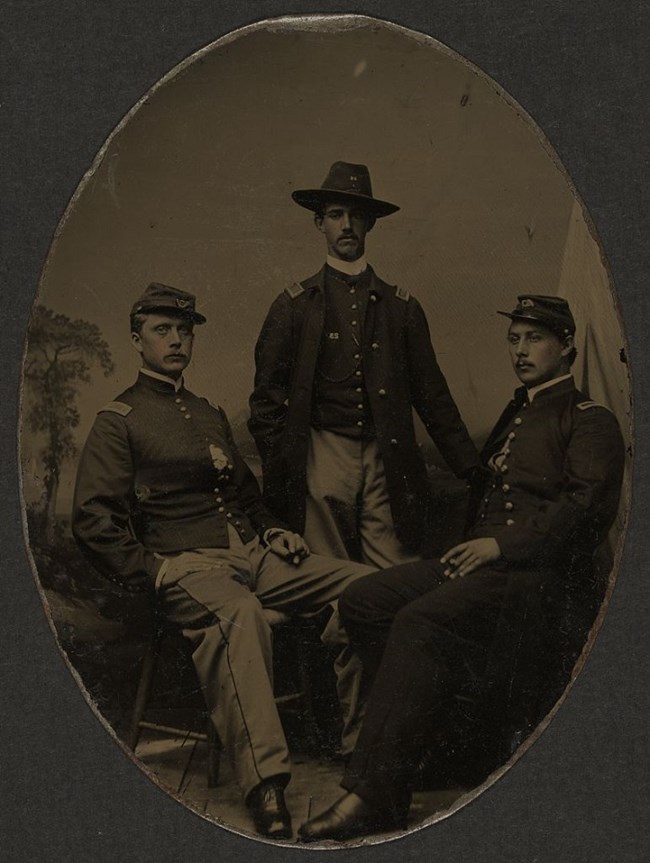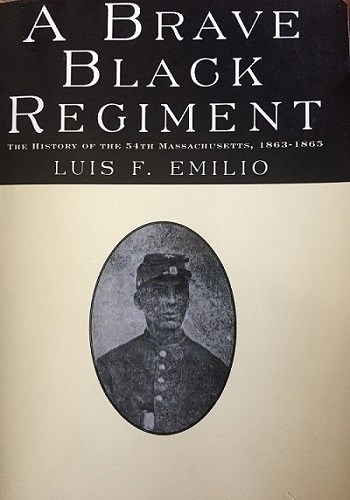Last updated: March 23, 2023
Article
Luis F. Emilio: Captain and Story Keeper of the 54th MA Regiment

William H. Powell, Officers of the Army and Navy (Volunteer) Who Served in the Civil War (Philadelphia, PA: L.R. Hamersly & Co., 1893), p. 39.
The Emilio Family in Salem
In the 1830s, Manuel Emilio and his future brother-in-law, Manuel Fenollosa, left Spain on a US Navy frigate as the members of a military band. After civil war broke out in Spain, their home country turned into a place of unrest as divisions among Spaniards grew.[1] Amidst this uncertainty, the two men left their home and family as they set off for a new life.[2]
After traveling the United States as a band leader, Emilio decided to start a new life in Salem, Massachusetts. His bride-to-be, Isabel Fenollosa, arrived from Spain afterwards and married Emilio on February 27, 1844.[3] On December 22, 1844, Manuel and Isabel Emilio welcomed their first child, Luis Emilio into the world.[4]
Luis Emilio grew up in a state known for its strong abolitionist values. Like Boston, Salem had an active and growing abolitionist community. Home to the first all-female anti-slavery society and influential abolitionists such as Charles and Sarah Parker Remond, many Salem residents joined the movement to organize and fight for the end of slavery.[5] The Emilio family also aligned themselves with abolitionists, as seen in the music composed by Manuel Emilio and Manuel Fenollosa that featured anti-slavery themes.[6] One song with music composed by Manuel Emilio, "Little Eva; Uncle Tom’s Guardian Angel," included a dedication note to Harriet Beecher Stowe and drew its inspiration from her best-selling novel.[7] When the country erupted into Civil War, Luis Emilio displayed a strong desire to aid in the abolitionist cause by serving in the military.
Rising in the Ranks
Following in the footsteps of his father and grandfather, Emilio sought to serve in the army.[8] At only 16 years old, Emilio did not yet meet the age requirement to enlist. To overcome this obstacle, he reported his age as 18 years old and enlisted in the Union Army on October 19, 1861. Soon after, he mustered into Company F of the 23rd Massachusetts Infantry on December 4, 1861.[9] At the Battle of Roanoke Island in 1862, Emilio engaged in combat for the first time. His confidence and bravery continued to impress his superiors which led to a spot in the color guard and a promotion to sergeant.[10]

Group shot, officers of the 54th Mass. Colored. United States, 1863. Photograph. https://www.loc.gov/item/2010650833/.
Serving with the 54th
The Emancipation Proclamation issued by President Lincoln in 1863 opened the doors of the military to African American men. Massachusetts Governor John Andrew strongly advocated for this measure. Once he received the order to raise an "all-colored" regiment, Governor Andrew set about the careful selection of the commander and officers needed to lead the 54th Massachusetts Infantry Regiment. Andrew knew that a skeptical public doubted the abilities of Black men to serve as soldiers. He also knew that all eyes would be watching this regiment closely. Therefore, he carefully chose the best men as leaders of this regiment. Writing to the father of future commander Robert Gould Shaw, Andrew expressed his wish for officers to be gentlemen "of firm anti-slavery principles, ambitious, superior to a vulgar contempt of color, and having faith in the capacity of colored men in the military service."[11]
Emilio's actions with the 23rd had proven his worth as an officer while his parents’ actions demonstrated the family's anti-slavery sentiments. Governor Andrew offered Emilio a commission with the 54th, which he chose to accept after Robert Gould Shaw sent a personal letter.[12] Luis Emilio mustered into the 54th as a 2nd Lieutenant on March 30, 1863. He continued to rise in the ranks, promoted from 1st Lieutenant to Captain of Company E in the span of 2 months.
In July of 1863, the 54th reported to Charleston, South Carolina to prepare to assault the fortifications surrounding the harbor. On July 16th, the 54th engaged in action for the first time, fighting off a Confederate assault at the Battle of Grimball's Landing on James Island. Two days later, the 54th accepted the command to lead the assault on Fort Wagner. At the famous assault on Fort Wagner, the 54th led the charging column. Tragically, the attack left many soldiers dead or wounded. As the 9th officer in line, Emilio emerged as the acting commander of the 54th. Though the assault resulted in great loss, the bravery of the men inspired hope across the country and increased efforts to recruit Black soldiers to fight.
After the assault on Fort Wagner, Emilio continued to serve dutifully in the Union Army. He commanded elements of the 54th in locations including Black Island, Fort Greene, Boyd's Landing, Devaux's Neck, Tullifinny and the Battle of Olustee.[13] His last engagement came on February 7, 1865. After three long years of serving during the U.S. Civil War, Emilio mustered out of the Union Army on March 29, 1865. At just 20 years old, Emilio received his honorable discharge.[14]

NPS Photo
Legacy of Emilio
After the war, Luis Emilio moved to San Francisco in 1867, where he worked for a real estate association.[15] In 1876, he married Mary Elizabeth Belden and later had a son, Victor Emilio.[16] In 1881, he returned to the East Coast with his family and settled in New York City.[17]
Throughout the rest of his life, Emilio maintained a strong interest in veteran affairs and military history. Many newspapers mention his membership in veteran societies such as the Military Order of the Loyal Legion.[18] He attended several veteran’s meetings and reunions.[19] Emilio also dedicated much time and effort in researching and collecting materials to share the history of the men of the 54th. He regularly contributed personal accounts to newspapers summarizing the assault on Fort Wagner. Eventually, his extensive research led him to write a book on the history of the 54th, publishing A Brave Black Regiment: History of the Fifty-Fourth Regiment of the Massachusetts Infantry, 1863-1865 in 1891. For officers of the 54th, the book served as the official regimental history.[20] Today, the book remains as the "foundation for all future research" on the heroic efforts of the men of the 54th and preserves the glory of their story.[21]
After a lifetime of dedication to his family, country and fellow soldiers, Luis Emilio died in New York at the age of 73 on September 16, 1918. Buried in his hometown of Salem, his grave remains a memorial to the life of this "gallant soldier."[22]
Contributed by: Sherry Guillen, Park Guide
Questions to Consider:
- Why did Luis Emilio's father and uncle decide to immigrate to the United States?
- How did Luis Emilio's family and youth experiences influence the rest of his life? Who in your life has influenced you?
- Why did Luis Emilio spend so much time and energy in researching and writing the history of the Massachusetts 54th Infantry Regiment?
- Why is it important to remember the story of the 54th?
Footnotes
[1] Ernest Fenollosa and Mary Fenollosa, “Preface,” in Epochs of Chinese and Japanese Art: an Outline History of East Asiatic Design: in Two Volumes (NY: Frederick A. Stokes company, 1912), p. xvii-xiii.
[2] Ernest Fenollosa and Mary Fenollosa, “Preface,” in Epochs of Chinese and Japanese Art: an Outline History of East Asiatic Design: in Two Volumes (NY: Frederick A. Stokes company, 1912), p. xvii-xiii.
[3] Ernest Fenollosa and Mary Fenollosa, “Preface,” in Epochs of Chinese and Japanese Art: an Outline History of East Asiatic Design: in Two Volumes (NY: Frederick A. Stokes company, 1912), p. xvii-xiii.; “Matrimony Notice.” Salem Register, February 29, 1844.
[4] Essex Institute, Vital Records of Salem, Massachusetts, to the End of the Year 1849, vol. 1 (Salem, MA: Essex Institute, 1916), p. 278.
[5] Dorothy Burnett Porter, “The Remonds of Salem, Massachusetts: A Nineteenth-Century Family Revisited,” Proceedings of the American Antiquarian Society 95, no. 2 (1985), p. 259-295.
[6] Fenollosa, Manuel, and R. T L. Emancipation Hymn. Oliver Ditson & Co., Boston, 1863. Notated Music. https://www.loc.gov/item/ihas.200001094/.
[7] Emilio, Manuel., Harriet Beecher Stowe, and John Greenleaf Whittier. Little Eva Song: Uncle Tom's Guardian Angel. [Boston: John P. Jewett & Co., 1852].
[8] William H. Powell, Officers of the Army and Navy (Volunteer) Who Served in the Civil War (Philadelphia, PA: L.R. Hamersly & Co., 1893), p. 39.
[9] Emilio, Luis F., and Gregory J.W. Urwin. “Introduction to the Da Capo Edition.” Introduction. In A Brave Black Regiment: the History of the Fifty-Fourth Regiment of Massachusetts Volunteer Infantry, 1863-1865, v-xv. New York, NY: Da Capo Press, 1995.
[10] William H. Powell, Officers of the Army and Navy (Volunteer) Who Served in the Civil War (Philadelphia, PA: L.R. Hamersly & Co., 1893), p. 39.
[11] Emilio, Luis F., A Brave Black Regiment: History of The Fifty-Fourth Regiment of Massachusetts Volunteer Infantry 1863-1865, New York, NY: Da Capo Press, 1995, 3.
[12] William H. Powell, Officers of the Army and Navy (Volunteer) Who Served in the Civil War (Philadelphia, PA: L.R. Hamersly & Co., 1893), p. 39.
[13] William H. Powell, Officers of the Army and Navy (Volunteer) Who Served in the Civil War (Philadelphia, PA: L.R. Hamersly & Co., 1893), p. 39.
[14] Emilio, Luis F., and Gregory J.W. Urwin. “Introduction to the Da Capo Edition.” Introduction. In A Brave Black Regiment: the History of the Fifty-Fourth Regiment of Massachusetts Volunteer Infantry, 1863-1865, v-xv. New York, NY: Da Capo Press, 1995.
[15] “The Real Estate Associates.” San Francisco Chronicle, January 21, 1875.
[16] “Married.” Salem Register, April 3, 1876.
[17] Emilio, Luis F., and Gregory J.W. Urwin. “Introduction to the Da Capo Edition.” Introduction. In A Brave Black Regiment: the History of the Fifty-Fourth Regiment of Massachusetts Volunteer Infantry, 1863-1865, v-xv. New York, NY: Da Capo Press, 1995.
[18] William H. Powell, Officers of the Army and Navy (Volunteer) Who Served in the Civil War (Philadelphia, PA: L.R. Hamersly & Co., 1893), p. 39.
[19] “Ex-Officers Dinner of the 54th and 55th,” The Boston Herald, November 12, 1885.; “New York City.” New York Tribune, January 28, 1890.
[20] Emilio, Luis F., and Gregory J.W. Urwin. “Introduction to the Da Capo Edition.” Introduction. In A Brave Black Regiment: the History of the Fifty-Fourth Regiment of Massachusetts Volunteer Infantry, 1863-1865, v-xv. New York, NY: Da Capo Press, 1995.
[21] Emilio, Luis F., and Gregory J.W. Urwin. “Introduction to the Da Capo Edition.” Introduction. In A Brave Black Regiment: the History of the Fifty-Fourth Regiment of Massachusetts Volunteer Infantry, 1863-1865, v-xv. New York, NY: Da Capo Press, 1995.
[22] Emilio, Luis Fenollosa, FindAGrave.com, https://www.findagrave.com/memorial/9375584/luis-fenellosa-emilio.
Tags
- boston african american national historic site
- salem maritime national historical park
- 54th
- 54th ma regiment
- 54th massachusetts
- 54th regiment
- 54th massachusetts regiment
- 54th mass
- luis emilio
- fort wagner
- african american history
- civil war
- union officers
- union army
- hispanic
- hispanic heritage
- hispanic and latino american history
- civil war history
- abolitionism
- faces of the 54th
- 54th gallery
- unfinished 250
